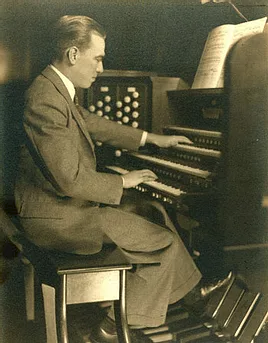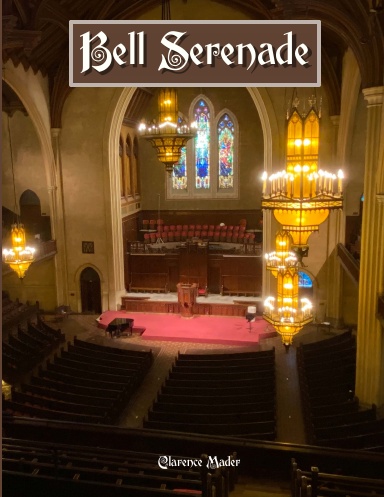
Clarence Mader, organist, teacher, composer, was born in 1904 in Easton Pennsylvania, and he died in 1971 in Laguna Hills, California. A pupil of Lynnwood Farnam, he held two prominent positions in Los Angeles, California as organist at Immanuel Presbyterian Church, and head of the organ department at Occidental College. Former students include David and Marian Reiff Craighead, Thomas Murray, Orpha Ochse, Ladd Thomas, and many others.
His service to the American Guild of Organists included: California State Chairman for six years, Dean of the Los Angeles Chapter, Program Chairman for the 1962 National Convention, National Councillor, and frequent performer at national conventions, festivals, and church music workshops. Active in the choral field, he was a founder and first president of the Choral Conductors Guild of California, now known as the National Association of Church Musicians.
The compositions of Clarence Mader reflect a masterly grasp of diverse musical styles and the indispensable gift of inspiration. Vision of St. Stephen, a sacred opera first performed in 1953, and Concerto for Organ, premiered in 1968, illustrate the broad range of his compositions. The Fifth Mystery, a choral work employing serial techniques, stands as a reminder of his abilities both as poet and as composer. Considered by family, friends and colleagues to have been a true renaissance man, he painted over forty pieces of art and composed more than seventy pieces of poetry. (bio courtesy of Dr. Jacob Benda)
We are honored to have been asked by the board of the Ruth and Clarence Mader Scholarship Fund to typeset and present the organ works of Clarence Mader – special thanks to Cherry Rhodes and Jacob Benda for proofreading, editing and giving valuable insights about this music.
Bell Serenade
This work was likely composed for the 1929 E.M. Skinner organ at Immanuel Presbyterian Church in Los Angeles, and is one of few works autographed with Mader’s nom de plume, Victor Easton. Victor, his middle name, and Easton, his birthplace. Undated, this miniature sounds as though it could have been inspired by a fond memory from the composer’s childhood in rural Pennsylvania, such as the bells of St. Peter’s Church echoing in tandem with the song of a wood thrush.
The original manuscript indicates, “this piece is arranged for two manuals and pedal. It can also be played when bells are controlled from the little two-octave clavier. On larger organs, mm. 37-46 may be ‘thumbed.” This approach can be successively navigated by playing the right-hand passage in mm. 39-42 one octave lower at 4’ pitch. Registration of Bell Serenade, or any of his solo organ works, is largely dependent upon the interpreter’s imagination and the resources at hand. I have found that an enclosed chime, or harp, is ideal for the ‘bell’ registration notated by the composer in measure one; if no bell-like sounds are available within the specification of the organ itself, this piece can be performed rather convincingly with organ and handbells.
The earliest documented performance was given by Marian Reiff Craighead on February 9th , 1948, at First Baptist Church in Bakersfield, California.
Order a printed copy | $8.99
Afternoon of Toad
Afternoon of a Toad was written sometime before 1949. Not typical of the usual serious nature of his compositions, this work is a compilation of short vignettes employing different secular styles of music used in the twentieth century including swing bass, rag, and jazz with riffs and flourishes. Additional sections reminiscent of Debussy and Stravinsky are woven together by Mader in his own distinctive style. Each of these sections offers opportunities for interpretation with lilting freedom. A French-style toccata brings the work to its dramatic close. Why was Mader compelled to write this piece? He remarked to his friends that there were many compositions written about animals such as The Carnival of the Animals, Peter and the Wolf, The Flight of the Bumblebee, and that the toad was woefully neglected! In his humorous way, he penned the title referencing Debussy’s Afternoon of a Faun. There are neither dynamic nor registration markings in Mader’s manuscript. Therefore, one has carte blanche for many options that will change from instrument to instrument. Registration ideas printed in the score are merely an example of myriad possibilities. Although these registrations are conceived for an organ of three or four manuals, they can be adapted very successfully to a two-manual instrument. Only one manual indication was written on Mader’s manuscript: in measure 90, left hand chords are to be played on the Solo (large reed). Often, from my experience, it has been more effective to keep these chords on the Great and then, at measure 92, to add solo reed(s) coupled to the Great while cascading down with this dramatic sound. In addition to fingerings, notes and slurs in brackets are options provided by this editor. For over forty years, I have performed this work in concert halls, cathedrals, and churches throughout many countries to enthusiastic listeners. It is such a pleasure to share it with you and your audiences through this publication. May the player of this witty work have much enjoyment accompanying the Toad during his many adventures!
– Cherry Rhodes
Order a printed copy $17.23

